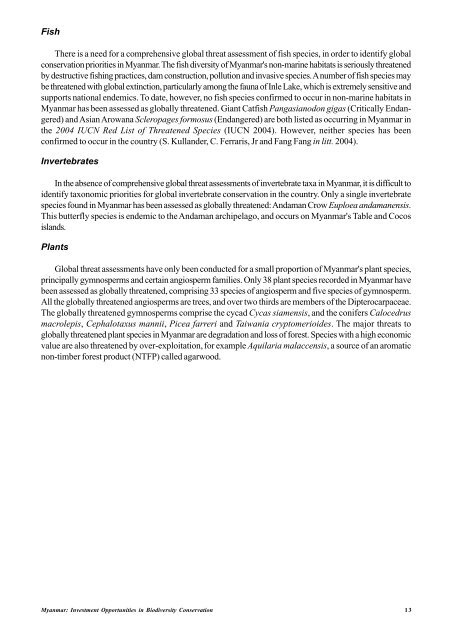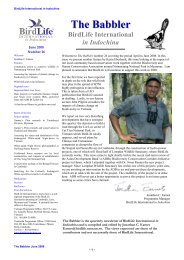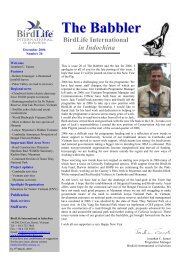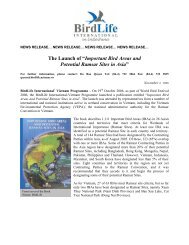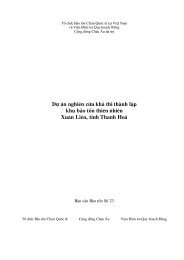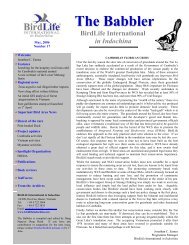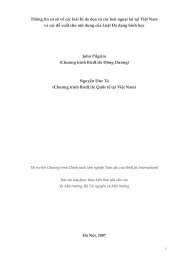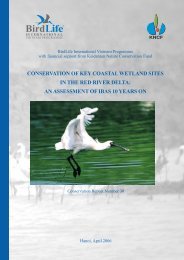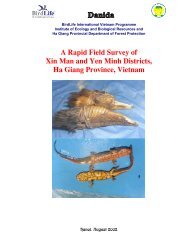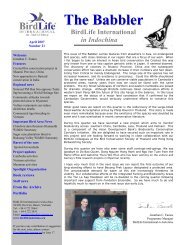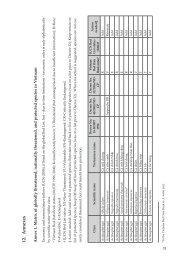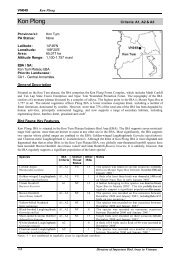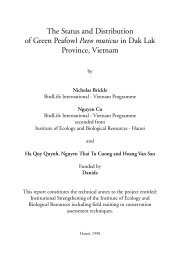Myanmar: Investment Opportunities in Biodiversity Conservation
Myanmar: Investment Opportunities in Biodiversity Conservation
Myanmar: Investment Opportunities in Biodiversity Conservation
Create successful ePaper yourself
Turn your PDF publications into a flip-book with our unique Google optimized e-Paper software.
Fish<br />
There is a need for a comprehensive global threat assessment of fish species, <strong>in</strong> order to identify global<br />
conservation priorities <strong>in</strong> <strong>Myanmar</strong>. The fish diversity of <strong>Myanmar</strong>'s non-mar<strong>in</strong>e habitats is seriously threatened<br />
by destructive fish<strong>in</strong>g practices, dam construction, pollution and <strong>in</strong>vasive species. A number of fish species may<br />
be threatened with global ext<strong>in</strong>ction, particularly among the fauna of Inle Lake, which is extremely sensitive and<br />
supports national endemics. To date, however, no fish species confirmed to occur <strong>in</strong> non-mar<strong>in</strong>e habitats <strong>in</strong><br />
<strong>Myanmar</strong> has been assessed as globally threatened. Giant Catfish Pangasianodon gigas (Critically Endangered)<br />
and Asian Arowana Scleropages formosus (Endangered) are both listed as occurr<strong>in</strong>g <strong>in</strong> <strong>Myanmar</strong> <strong>in</strong><br />
the 2004 IUCN Red List of Threatened Species (IUCN 2004). However, neither species has been<br />
confirmed to occur <strong>in</strong> the country (S. Kullander, C. Ferraris, Jr and Fang Fang <strong>in</strong> litt. 2004).<br />
Invertebrates<br />
In the absence of comprehensive global threat assessments of <strong>in</strong>vertebrate taxa <strong>in</strong> <strong>Myanmar</strong>, it is difficult to<br />
identify taxonomic priorities for global <strong>in</strong>vertebrate conservation <strong>in</strong> the country. Only a s<strong>in</strong>gle <strong>in</strong>vertebrate<br />
species found <strong>in</strong> <strong>Myanmar</strong> has been assessed as globally threatened: Andaman Crow Euploea andamanensis.<br />
This butterfly species is endemic to the Andaman archipelago, and occurs on <strong>Myanmar</strong>'s Table and Cocos<br />
islands.<br />
Plants<br />
Global threat assessments have only been conducted for a small proportion of <strong>Myanmar</strong>'s plant species,<br />
pr<strong>in</strong>cipally gymnosperms and certa<strong>in</strong> angiosperm families. Only 38 plant species recorded <strong>in</strong> <strong>Myanmar</strong> have<br />
been assessed as globally threatened, compris<strong>in</strong>g 33 species of angiosperm and five species of gymnosperm.<br />
All the globally threatened angiosperms are trees, and over two thirds are members of the Dipterocarpaceae.<br />
The globally threatened gymnosperms comprise the cycad Cycas siamensis, and the conifers Calocedrus<br />
macrolepis, Cephalotaxus mannii, Picea farreri and Taiwania cryptomerioides. The major threats to<br />
globally threatened plant species <strong>in</strong> <strong>Myanmar</strong> are degradation and loss of forest. Species with a high economic<br />
value are also threatened by over-exploitation, for example Aquilaria malaccensis, a source of an aromatic<br />
non-timber forest product (NTFP) called agarwood.<br />
<strong>Myanmar</strong>: <strong>Investment</strong> <strong>Opportunities</strong> <strong>in</strong> <strong>Biodiversity</strong> <strong>Conservation</strong><br />
13


